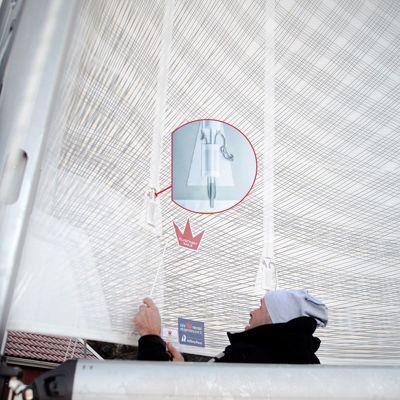
Mainsails - for cruising and racing
The mainsail is a fundamental part of your sailing boat. A well performing mainsail is vital for the overall handling and performance of your boat.
A good mainsail is the source of balance for your boat, and you'll know when it's right. When the boat could almost steer itself. Comfortable cruising is a very important factor at Elvstrøm Sails, which is why we have more than three decades of experience in furling sails and optimizing sails for in-mast furling and in-boom furling.
It also applies for conventional setups - every day, we strive to make the most balanced and well-handling sails for cruisers and racers alike.
Here, we will dive deeper into the different technical solutions when it comes to Mainsails, which are generally delivered in three types of materials from Elvstrøm Sails: Dacron, laminates and our membrane sails, EPEX.
Handling - conventional mainsails and furling mainsails
When it comes to the handling of the mainsail, this is also where the mainsail becomes a sail with a few options and features to take into account.
First up is the traditional solution - the conventional mainsail. A conventional mainsail is folded over the boom when it's not in use, and then hoisted for use, and should the need for reefing the mainsail arise, it's reefed the traditional way with reefing points in tack and clew.
A set of the so-called reefing diamonds can also be added in between these two points to add further options for reefing in the most stable way possible.
Consult your local Elvstrøm Sail Point to decide how many reefing points your particular mainsail will need - adding more points makes the sail heavier and more expensive, so it's always a good idea to consider what you will need.
The furling systems - In-Mast Furling Mainsail and In-Boom Furling Mainsail
At Elvstrøm Sails, we do of course offer the conventional mainsail types, but with the addition of furling, it is also available as In-Mast and In-Boom furling options - all depending on your boat and naturally, the rig setup.
Furling has been an important part of our product programme since the 90's and it still is today. In this article, you can dive deeper into the advantages of furling sails with our expert, Søren Hansen.
Furling sails are made with easier handling in mind, so here you will not need to undo a sail cover or open a zippack to get started - just furl out the sail, and you're away.
And should you need to depower the mainsail in stronger winds, reefing has never been easier. Just furl in a section or two of the sail, and you have already depowered it. Combined with the widespread use of battens - often in full length - the risk of flogging will be kept at a minimum even in these conditions.

Mainsail materials and layouts
Regarding mainsails - and headsails for that matter - you will see that the layouts and materials often follow each other.
Generally speaking, there are three variations of mainsails.
The three general versions to suit different performance needs and different budgets are:
Crosscut or X-Cut Dacron Mainsails
Crosscut layouts are often used with Dacron or similar polyester materials. This layout is made from horizontal panels which all run perpendicular to the leech of the sail. This was the original way of constructing a sail per se, and it makes for a long-lasting and price-consious sail as the production is very effective.
Radial or Tri-Radial Dacron Mainsails and Laminate Mainsails
The Radial sail layout, also known as the tri-radial, has the panels oriented in a triangular shape. This design is ultimately a better performing sail than a crosscut sail as it distributes the forces better towards the three corners of the sail, and this also helps it keeping a more optimal shape.
It is a little more expensive to construct, but in general it also comes with more options in terms of materials as laminates are often used here.
Laminates are also the natural next step after dacron in terms of strength and shape-keeping. The laminate has strength in all directions, whereas regular dacron is directional.
Membrane sails - EPEX sails and XYLO
The membrane is the third variant, and this is where you find EPEX and our latest addition, XYLO.
The idea of a membrane sail is to construct a custom design made fully for the boat and the application in question. In both instances, the fibres are spread out in a design which takes the loads of the sail into account. Then, the fibres are bonded under vacuum to create the membrane.
This makes these sails super strong, and as the design process is digital, it also takes the shape into account all the way through.